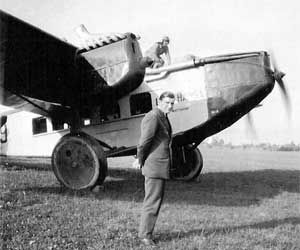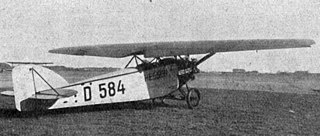
The Fokker D.VII was a German World War I fighter aircraft designed by Reinhold Platz of the Fokker-Flugzeugwerke. Germany produced around 3,300 D.VII aircraft in the second half of 1918. In service with the Luftstreitkräfte, the D.VII quickly proved itself to be a formidable aircraft. The Armistice ending the war specifically required, as the fourth clause of the "Clauses Relating to the Western Front", that Germany was required to surrender all D.VIIs to the Allies. Surviving aircraft saw much service with many countries in the years after World War I.

The Heinkel He 70 Blitz ("lightning") was a German mail plane and fast passenger monoplane aircraft of the 1930s designed by Heinkel Flugzeugwerke, which was later used as a bomber and for aerial reconnaissance. It had a brief commercial career before it was replaced by larger types. The He 70 had set eight world speed records by the beginning of 1933.

The Junkers F 13 is the world's first all-metal transport aircraft, developed in Germany at the end of World War I. It was a cantilever-wing monoplane, with enclosed accommodation for four passengers and a two seat open cockpit. 322 examples were manufactured, an exceptionally large number for a commercial airliner of the era, and were operated all over the world. It accounted for over a third of air traffic in the early 1920s. It remained in production for thirteen years and in commercial service for more than thirty. There were many versions including floatplanes for water landing, skis, mailplane, and different engines. Several survive in various states of repair in museums, and a replica of the type was put back in production in the 2010s, taking flight once again nearly a century after the type first flew.

The Fokker F.VII, also known as the Fokker Trimotor, was an airliner produced in the 1920s by the Dutch aircraft manufacturer Fokker, Fokker's American subsidiary Atlantic Aircraft Corporation, and several other companies under license. It was an airliner that could carry 6-12 people, depending on the version, and it used a variety of engines; early versions had one engine but three was more common.
Luft-Fahrzeug-Gesellschaft, also referred to as LFG, was a German aircraft manufacturer during World War I. They are best known for their various "Roland" designs, notably the Roland C.II Walfisch (whale), Roland D.II haifisch (Shark) and Roland D.VI, although they also produced a number of airships and many experimental designs.

The Fokker F.VIII was a large twin-engined airliner designed and produced by the Dutch aircraft manufacturer Fokker in the 1920s.

The Junkers G 24 was a German three-engine, all-metal low-wing monoplane passenger aircraft manufactured by Junkers from 1925. Junkers F 24 was the designation for single-engine versions of the same aircraft.

The Fokker F.IX was an airliner developed in the Netherlands in the late 1920s, intended to provide KLM with an aircraft suitable for regular services to the Dutch East Indies. When the onset of the Great Depression forced the postponement of those plans, the market for this aircraft disappeared as well, although it did see military service in Czechoslovakia as a bomber.

The Fokker F.XX was a 1930s Dutch three-engined airliner designed and built by Fokker. It was the first Fokker design to use an elliptical-section fuselage instead of the traditional square fuselage and the first Fokker aircraft with retractable landing gear.

The Fokker F.XXXVI was a 1930s Dutch four-engined 32-passenger airliner designed and built by Fokker. It was the largest transport designed and built by Fokker. Only one was built, and it was used for some commercial routes starting in 1935, and later aviation training by the British Royal Air Force until 1940.

The BFW M.20 was a German single-engine, high-wing monoplane ten-seat passenger transport aircraft, developed in the late 1920s and early 1930s. Deutsche Luft Hansa used it throughout the 1930s on a variety of routes.

The Dornier Komet (Comet), Merkur (Mercury), Do C, Do D, and Do T were a family of aircraft manufactured in Germany during the 1920s, originally as small airliners, but which saw military use as well. The earliest aircraft in the series were basically landplane versions of the Delphin flying boat, and although the Delphin and Komet/Merkur series diverged from each other, design changes and refinements from one family were often incorporated into the other. All variants were braced high-winged single-engine monoplanes with conventional landing gear.

The Fokker F.III was a single-engined high-winged monoplane aircraft produced in the 1920s by the Dutch aircraft manufacturer Fokker. It could carry five passengers. The aircraft was also built under licence in Germany as the Fokker-Grulich F.III.

The Focke-Wulf A 17 Möwe was an airliner built in Germany in the late 1920s. It was a conventional high-wing cantilever monoplane with fixed tailwheel undercarriage. The aircraft provided fully enclosed seating for up to eight passengers and had a separate, fully enclosed flight deck for the two pilots. Most examples flew with Deutsche Luft Hansa, serving until around 1936. In the early 1930s, two A 17s were used for testing the Junkers Jumo 5 diesel engine.

The Fokker F.XIV was a cargo plane built in the Netherlands in the late 1920s by Fokker. It was a high-wing cantilever monoplane of conventional trimotor layout. The sole example was tested by KLM but never put into service.

The Junkers G 31 was an advanced tri-motor airliner produced in small numbers in Germany in the 1920s. Like other Junkers types, it was an all-metal, low-wing cantilever monoplane. In the mid-1920s, the all-metal construction and an aerodynamically 'clean' configuration were remarkable.

The Rohrbach Ro VIII Roland was an airliner produced in Germany during the 1920s. It was a conventional strut-braced, high-wing monoplane, based loosely on the Zeppelin-Staaken E-4/20 that Adolf Rohrbach designed in 1920. It had a fully enclosed flight deck and passenger cabin, and featured fixed, tailskid undercarriage. Power was supplied by three engines, one in the nose, and two mounted in nacelles on the wings. Construction was of metal throughout.

The Sablatnig P.III was an airliner produced in Germany in the early 1920s.

The Douglas DC-2 is a 14-passenger, twin-engined airliner that was produced by the American company Douglas Aircraft Company starting in 1934. It competed with the Boeing 247. In 1935, Douglas produced a larger version called the DC-3, which became one of the most successful aircraft in history.

The Grulich S.1 was a German parasol monoplane with a cantilever wing, built in the mid 1920s. It seated two and offered a choice between two engines.
























